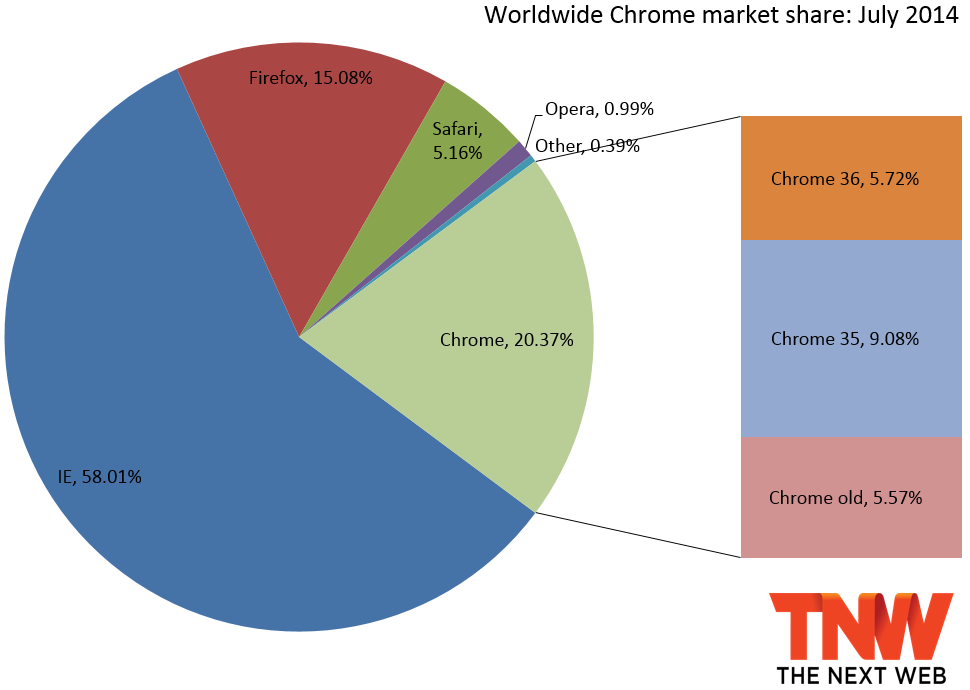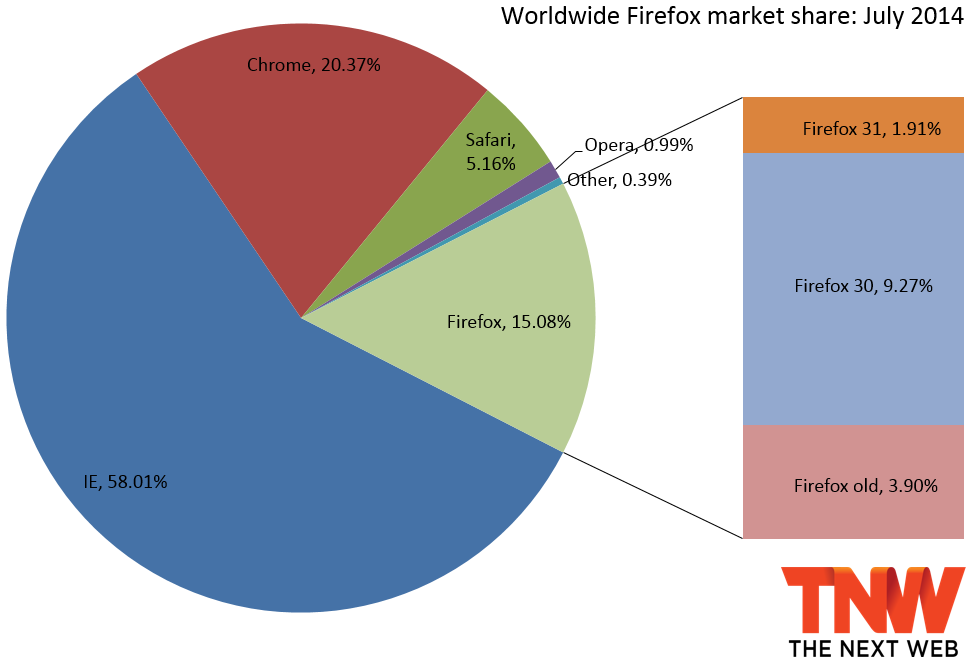
July saw the ninth full month of IE11 availability with Windows 8.1, as well as the release of Chrome 36 and Firefox 31. The latest numbers from Net Applications show that Chrome was once again the only major winner last month, further widening its second place lead over Firefox.
Between June and July, IE fell 0.37 percentage points (from 58.38 percent to 57.88 percent), Chrome gained 1.03 percentage points (from 19.34 percent to 20.37 percent), and Firefox fell 0.46 percentage points (from 15.54 percent to 15.08 percent). Safari meanwhile slipped 0.12 percentage points to 5.16 percent and Opera dipped 0.06 percentage points to 0.99 percent.
At 58.01 percent, Internet Explorer is slightly below its highest point in 2014 (the previous month it was at 58.38 percent). Last January, the browser went back above the 55 percent mark, and ever since we’ve been watching to see if it can get above the 60 percent mark again.
In July, IE11 fell 0.23 percentage points (from 17.01 percent to 16.78 percent). IE10 declined 0.11 percentage points to 6.26 percent while IE9 gained 0.03 percentage points to 9.06 percent.
Although IE11 recently passed IE10 and IE9 combined, it doesn’t seem as if its recent peak of 17 percent will be breached (and Windows 8.1 isn’t helping). This can of course change, but right now it appears as if IE12, or whatever Microsoft ends up calling IE11’s successor, will be tasked with the job of dethroning IE8.
IE8 gained 0.31 percentage points, and it’s still the world’s most popular browser at 21.56 percent. IE11 continues to mainly steal market share from IE10 and IE9, since Windows XP users can’t upgrade past IE8, and the end of support for the ancient OS hasn’t impacted that trend. IE7 fell 0.09 percentage points to 0.62 percent and IE6 fell 0.29 percentage points to 3.52 percent.
At 20.37 percent, Chrome has once again hit a new high. Not only did it finally pass Firefox in March, but it has managed to cement its position.
Chrome 36 grabbed a starting 5.72 percent, a number which would have been higher if the browser version was available for a full month. All other versions were down: Chrome 35, Chrome 34, Chrome 33, and Chrome 32 fell a combined 3.83 points.
At 15.08 percent, Firefox is lower than it has been for more than five years. The release of Firefox 29, a major revamp of the browser, has not helped Mozilla’s situation.
Firefox 31 managed to start off with 1.91 market share last month. Firefox 30 also grew to 9.27 percent, while all other versions were down: Firefox 29, Firefox 28, and Firefox 27 fell a combined 5.49 points.
Net Applications uses data captured from 160 million unique visitors each month by monitoring some 40,000 websites for its clients. StatCounter is another popular service for watching market share moves; the company looks at 15 billion page views. To us, it makes more sense to keep track of users than page views (for more, see this post).
Nevertheless, for July 2014, StatCounter listed Chrome as first with 45.28 percent, IE in second with 21.38 percent, Firefox in third with 17.52 percent, Safari with 10.60 percent, and Opera with 1.39 percent. The only part everyone agrees on is that Safari and Opera are not in the top three.
See also – Windows XP falls below 25% market share while Windows 8.1 loses share for the first time
Top Image Credit: Hugo Humberto Plácido da Silva
Get the TNW newsletter
Get the most important tech news in your inbox each week.







